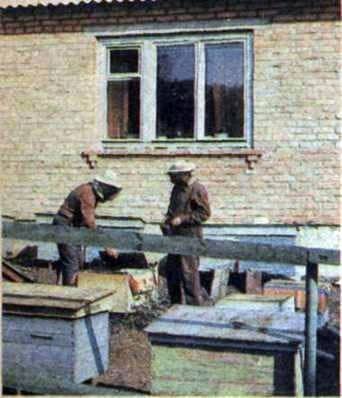
A significant number of lovers, to buy one or two bee colonies, want to increase them quickly. There are two ways of accelerated reproduction: the first – the use of swarm queen cells, the second, effective, but more complex, – the artificial withdrawal of queens and the formation of layers. For the accelerated breeding, the strongest bee colonies are distinguished, which have overwintered well. By autumn, weak families will grow and with excellent care will also become strong.
Use of swarm queen cells
When the bees from the spring get so strong that they fill the entire nesting corps of the twelve-frame hive, they prepare for swarming and lay the queen egg quarters. For the family to do this faster, cut the nest, where the bees become crowded, thicken the streets, bringing the frames together to 8-9 mm, the hive is carefully insulated, and the flock is reduced. If there is no honey collecting, daily give an incentive top dressing – 200 g of 50% sugar syrup.
When bees seal the first of the laid queen cells, and the first swarm comes out of the family with an old fruitful uterus, it is collected, and the uterus is selected. The bees of the swarm are passed through the distribution grid, then they return it to the hive, from which it came out. The selected fertile uterus is housed in a new hive, placing 2-3 frames with a printed brood and 2-3 with feed taken from the nest of the mother’s family.
On the 8th-9th day a second strong swarm with a young uterus will come from the family, which will consist of the bees of the first and second swarms. Such a strong swarm is collected in a sow, weighed and determined how many of it it is possible to form new families, for each there were 1-1.5 kg of swarm bees. For new families, hives are prepared, they carry 2-3 honeycombs from the nest of the mother’s family with the brood and bees that sit on them, but in order to have a honeycomb with a queen pot in each hive.
Add 2-3 frames with feed. Then, 1-1.5 kg of swarm bees are poured into prepared hives from the rovney. Excess mother cells of the bee destroy themselves, leaving only the uterus. If the swarm is released, for example, with a mass of 5 kg, you can have 3-4 new ones from the family. For swarm bees, it is characteristic that they remain in the same hive in which they are planted, so that all new families from the first day have flying bees, and after mating the queens and leaving the bees from brood become normal families of medium strength.
Artificial withdrawal of queens and formation of layers
The essence of this method consists in the periodic formation of 3-4 families from a strong family, for which young uteros are needed. They can be purchased in matko hatchery farms or taken out by yourself. From a strong family receive 15-20 queens for two doses with an interval of 5 days. In addition to individual layers (from one family), teams are formed, taking frames with brood from 2-3 families. Such layers can be found at earlier times, without weakening individual families.
For the simplest withdrawal from the family, the queens are selected, and in the nest select 1-2 honeycombs with young bee larvae. Honeycombs are cut so that from the bottom edge there is a row with young larvae no older than the diurnal age, suitable for the withdrawal of queens. In such extreme cells, the larvae are destroyed through one. On the left larvae the bees will be filled with queen cells, which will be sealed on the fifth day, and on the tenth they can be used to form the layers. From the family for selection, 2-3 honeycombs with a printed mature brood are selected, preferably with young bees that emerge from the cells. Cells are taken with bees that cover them, add another 2-3 honeycombs with feeds and shake extra bees from 1-2 honeycombs. For a day in the hive they close the ice. Between the frames with brood insert a mature motherhood or a cage with a uterus that emerged from the mother liquor.
Lead first queens in the second half of May, and the first layers form in late May or early June. After two weeks, the uterus in the layers begins to lay eggs. The brood is strengthened by putting another 1-2 honeycombs with a mature brood, without bees, and it becomes a full-fledged family. In the main family, which overwintered, instead of the selected honeycomb with brood put the same number of empty. In them, the uterus lays eggs and the number of honeycombs with brood resumes.
From such a family in two weeks you can select the second set, and then the third. Thus, from the strong family to the autumn have three new ones. Spring layers have time to increase to the main honey collector and to create fodder reserves for the winter, and in the best years also a surplus of marketable honey.
The efficiency of the layers is significantly increased if they are planted by fruitful queens grown by southern mathematics farms, where they are obtained in earlier periods, when this is still impossible in the central and northern regions
Нападение пчел. Ускоренное размножение.
The bee family and its composition